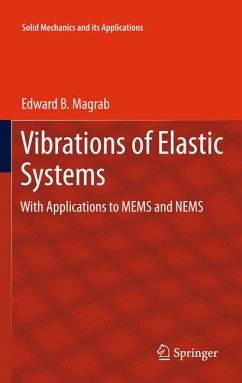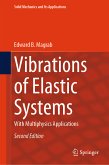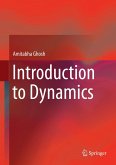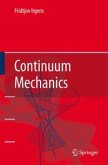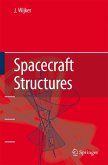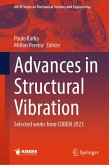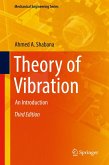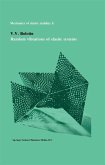

Alle Infos zum eBook verschenken

- Format: PDF
- Merkliste
- Auf die Merkliste
- Bewerten Bewerten
- Teilen
- Produkt teilen
- Produkterinnerung
- Produkterinnerung

Hier können Sie sich einloggen

Bitte loggen Sie sich zunächst in Ihr Kundenkonto ein oder registrieren Sie sich bei bücher.de, um das eBook-Abo tolino select nutzen zu können.
This work presents a unified approach to the vibrations of elastic systems as applied to MEMS devices, mechanical components, and civil structures.
Applications include atomic force microscopes, energy harvesters, and carbon nanotubes and consider such complicating effects as squeeze film damping, viscous fluid loading, in-plane forces, and proof mass interactions with their elastic supports. These effects are analyzed as single degree-of-freedom models and as more realistic elastic structures. The governing equations and boundary conditions for beams, plates, and shells with interior and…mehr
- Geräte: PC
- ohne Kopierschutz
- eBook Hilfe
- Größe: 10.14MB
![Vibrations of Elastic Systems (eBook, PDF) Vibrations of Elastic Systems (eBook, PDF)]() Edward B. MagrabVibrations of Elastic Systems (eBook, PDF)137,95 €
Edward B. MagrabVibrations of Elastic Systems (eBook, PDF)137,95 €![Introduction to Dynamics (eBook, PDF) Introduction to Dynamics (eBook, PDF)]() Amitabha GhoshIntroduction to Dynamics (eBook, PDF)40,95 €
Amitabha GhoshIntroduction to Dynamics (eBook, PDF)40,95 €![Continuum Mechanics (eBook, PDF) Continuum Mechanics (eBook, PDF)]() Fridtjov IrgensContinuum Mechanics (eBook, PDF)169,95 €
Fridtjov IrgensContinuum Mechanics (eBook, PDF)169,95 €![Spacecraft Structures (eBook, PDF) Spacecraft Structures (eBook, PDF)]() J. Jaap WijkerSpacecraft Structures (eBook, PDF)217,95 €
J. Jaap WijkerSpacecraft Structures (eBook, PDF)217,95 €![Advances in Structural Vibration (eBook, PDF) Advances in Structural Vibration (eBook, PDF)]() Advances in Structural Vibration (eBook, PDF)137,95 €
Advances in Structural Vibration (eBook, PDF)137,95 €![Theory of Vibration (eBook, PDF) Theory of Vibration (eBook, PDF)]() Ahmed A. ShabanaTheory of Vibration (eBook, PDF)73,95 €
Ahmed A. ShabanaTheory of Vibration (eBook, PDF)73,95 €![Random vibrations of elastic systems (eBook, PDF) Random vibrations of elastic systems (eBook, PDF)]() V. V. BolotinRandom vibrations of elastic systems (eBook, PDF)73,95 €
V. V. BolotinRandom vibrations of elastic systems (eBook, PDF)73,95 €-
-
-
Applications include atomic force microscopes, energy harvesters, and carbon nanotubes and consider such complicating effects as squeeze film damping, viscous fluid loading, in-plane forces, and proof mass interactions with their elastic supports. These effects are analyzed as single degree-of-freedom models and as more realistic elastic structures. The governing equations and boundary conditions for beams, plates, and shells with interior and boundary attachments are derived by applying variational calculus to an expression describing the energy of the system. The advantages of this approach regarding the generation of orthogonal functions and the Rayleigh-Ritz method are demonstrated.
A large number of graphs and tables are given to show the impact of various factors on the systems' natural frequencies, mode shapes, and responses.
Dieser Download kann aus rechtlichen Gründen nur mit Rechnungsadresse in A, B, BG, CY, CZ, D, DK, EW, E, FIN, F, GR, HR, H, IRL, I, LT, L, LR, M, NL, PL, P, R, S, SLO, SK ausgeliefert werden.
- Produktdetails
- Verlag: Springer Netherlands
- Seitenzahl: 492
- Erscheinungstermin: 12. Januar 2012
- Englisch
- ISBN-13: 9789400726727
- Artikelnr.: 37411444
- Verlag: Springer Netherlands
- Seitenzahl: 492
- Erscheinungstermin: 12. Januar 2012
- Englisch
- ISBN-13: 9789400726727
- Artikelnr.: 37411444
- Herstellerkennzeichnung Die Herstellerinformationen sind derzeit nicht verfügbar.
